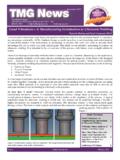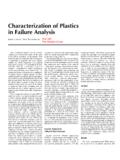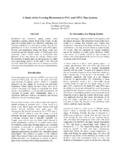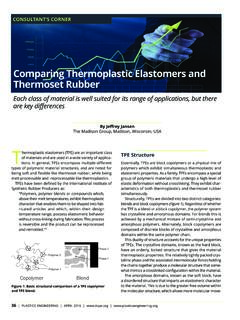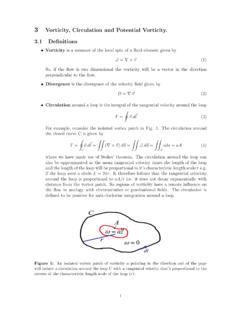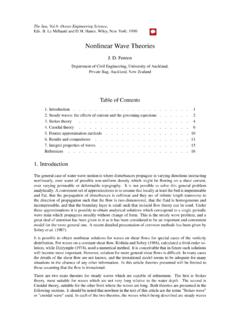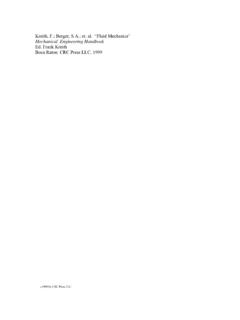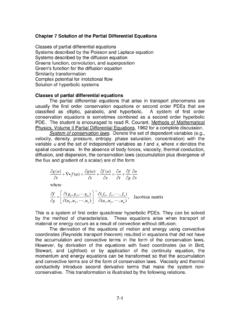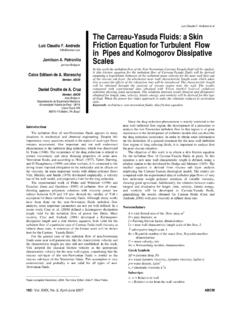Transcription of MAKING THE BREAKER PLATE OF AN EXTRUDER AN …
1 MAKING THE BREAKER PLATE OF AN EXTRUDER AN efficient mixing DEVICE AntoineRios, Enric Santanach, and Paul Gramann, The Madison Group Chris Rauwendaal, Rauwendaal Extrusion Engineering, Inc. Introduction During the compounding of polymers it is oftentimes desirable to create additional mixing if possible. This generally requires both distributive and dispersive mixing , where the dispersion of materials having widely different viscosities often poses the greatest difficulties. The best method to accomplish successful dispersive mixing is to expose the material to extensional flow. Furthermore, in terms of power consumption, extensional flows are far superior to the shear-type flows found in most mixing systems.
2 In most liquid-liquid mixing operations coalescence plays an important role (8). Coalescence is the fusing together of discrete droplets of the dispersed phase, thereby, causing a coarsening of the morphology. As a result, it is beneficial to achieve dispersive mixing as close to the die exit as possible. Generally, this involves putting a mixing section at the end of the screw. However, this can be an expensive and time consuming option. Further, after the material leaves the screw and travels to the screen pack/ BREAKER PLATE and/or die region, sufficient time may exist for coalescence to take place (1, 2). This article discusses a new device that was developed to create efficient mixing during this critical stage of processing; the mixing BREAKER PLATE (MBP) is a device that replaces the standard BREAKER PLATE .
3 mixing in Polymer Processing During the processing of polymers it is common to add additional compounds to the melt stream to produce color, enhance properties, or produce a polymer blend. However, these compounds or additives can have widely different properties, viscosity, which may cause significant mixing problems. Here, mixing demands of the system are significantly increased and the knowledge of what the system can produce is essential. Furthermore, it is often desirable to produce this mixing in the most economical fashion. In polymer processing, mixing can be distributive and/or dispersive. Distributive mixing involves the increase in spatial distance between solid agglomerates or droplets.
4 Dispersive mixing entails the breakup of these liquid or solid agglomerates to produce a finer level of dispersion. Here, a hydrodynamic force is applied to the agglomerate or droplet by the flow of material as it passes through the system. The type of flow that is created is a major factor in how effective the device will be in creating a dispersive mixing environment. Unfortunately, most of the current generation of mixers rely on shear-type flows. Typically, with these flows, a large degree of shear stress must be created to obtain any level of dispersion. Furthermore, it is well known in the polymer mixing community that dispersion of agglomerates by shear is ineffective at large viscosity ratios (3).
5 The classic study by Grace (3) showed that when the viscosity of the dispersed phase is greater than four times the matrix viscosity ( 1/ 2>4), simple shear flows cannot overcome the interfacial tension between the compounds, and droplets cannot be broken up. The study also showed that elongational flows are much more effective at dispersive mixing and do not exhibit a limit based on viscosity ratio up to a ratio of 1000:1. Elongational flows can also generate significantly higher stresses to disperse agglomerates. Accordingly, the resulting energy requirement to produce mixing is much lower than with shear flows. Based on the classic study by Erwin (4) in the 1970 s, Figure 1 shows the ratio of energy input requirements for shear and elongational flows to produce a specific dispersed phase size.
6 The graph shows that as the interfacial area of the agglomerates, A, is increased from the initial surface area, Ao, shear flow is an inefficient way to mix. As the figure illustrates, shear flows are always less efficient , require more energy, to produce an increase in interfacial area than elongational flows. Also readily evident from the figure is the fact that the energy required for elongational flow can be many orders of magnitude less than for shear flow. Given the advantages of elongational flow, some quantitative measures must be defined to numerically evaluate a new mixing device. One such measure, the flow number, has been extensively used by many authors (5-8) to ascertain the type of flow in a given geometry.
7 The flow number, , is defined by Eq. 1 in terms of the magnitude of the strain rate tensor, &, and the vorticity tensor, . The flow number is a measure of the type of flow in the system and varies between a value of 0 and 1. For a flow number of 0, the system is undergoing purely rotational flow and no effective mixing can occur. A flow number of denotes simple shear flow, while a value of denotes pure elongational flow. In commercial applications, whenever the flow number is greater than or equal to , the system is thought to be generating effective elongational flow for dispersion. +=&& (1) Equally important as the flow number, is the magnitude of the separation forces that the mixer can impart to the fluid.
8 In simple shear flow, the force that is applied is given by Eq. 2 (1), and for pure elongational flow by Eq. 3. 23rFsshear &= (2) 26rFeelong &= (3) Here, s is the shear viscosity of the carrier fluid, e the elongational viscosity, and r the radii of particles to be broken up. Considering the Trouton relationship, where the elongational viscosity is usually three times the shear viscosity, the equations indicate that elongational flows can generate substantially higher separation forces than shear flows. However, it should be noted that it is generally more difficult to achieve high elongational strain rates than high shear strain rates.
9 mixing devices Some common high shear mixing devices that are used in the polymer processing industry are the Maddock (LeRoy) fluted mixer, the blister ring, Egan mixing section, and various barrier screws (1). These are all dynamic mixing devices that are part of the screw. Because these devices generate a large amount of shear, degradation of the polymer and a high temperature increase must be taken into account. Recently, a new mixing device, named the CRD, was developed to generate elongational flows by incorporating tapered flights and wedge shaped slots (9). This device has been very successful in the dispersive mixing of difficult materials, while reducing the overall melt temperature (10).
10 Another type of mixer that is common in polymer processing is the static mixer. This device is not attached to the screw, and as the name suggest, it is a stationary object. Because the flow of material creates the only relative motion between the mixing device and the polymer, the type of flow created is extremely important when considering dispersive mixing . Fluids entering a static mixer are typically divided by baffles and mixing occurs by the continual splitting and recombination of flow streams. The current state of the art of static mixers for the polymer industry can produce an extremely uniform mixture for materials with nearly equal viscosities.
